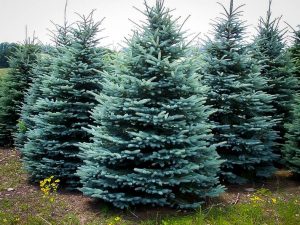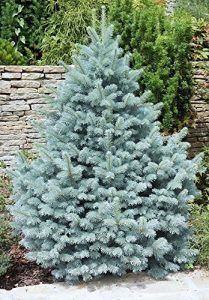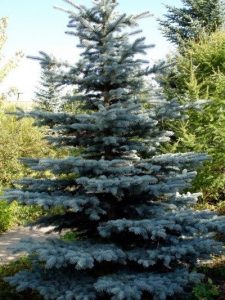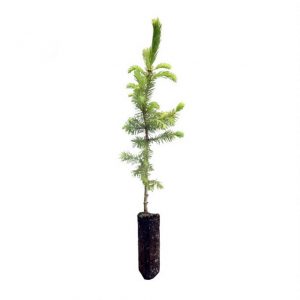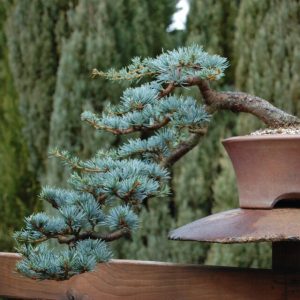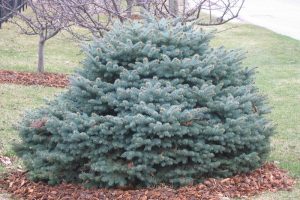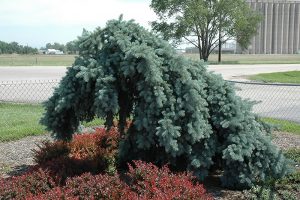Blue Spruce
The blue spruce is an extremely resilient species that can withstand massive temperature changes, air pollution, and draught. They belong to the pine family.
Scientific Classification
| Kingdom | Plantae |
| Division | Pinophyta |
| Class | Pinopsida |
| Order | Pinales |
| Family | Pinaceae |
| Genus | Picea |
| Scientific Name | Picea pungens |
Quick Information
| Other Names | Colorado blue spruce, Colorado spruce, and green spruce, water spruce |
| Tree Type | Evergreen conifer |
| Identification | Height: Around 50-75 ft (15.24-22.8 m) sometimes as tall as 150 ft (45.7 m) Needles: Bluish green pointed needles sizing around 1 in (3 cm) Trunk Diameter: Around 5 ft (1.5 m) Cones: Pale brown in color with an approximate length of 4 in (10.16 cm) Bark: Scaly and grey Branches: Yellowish-brown |
| Distribution/Range | Southern and central Rocky Mountains including Colorado, Utah, New Mexico, Wyoming, Arizona, and Idaho |
| Habitat | Humid canyon bottoms, steep mountain ranges of fir and spruce woods, mid-montane forests at elevations of 5,905-9,842 ft |
| Hardiness Zones | 3-7 |
| Growth Rate | Slow |
| Lifespan | 150-600 years |
| Growing Conditions | Soil Requirements: Mineral and moisture enriched soil Light Requirements: Balanced exposure to sun and shade |
| Diseases & Pests | Diseases: Fungi-caused cankers or plant disease and needle casting ailments Pests: Pineapple gall adelgid, nymphs, spruce budworm, pine needle scales, spruce beetles |
| Reproductive System | Monoecious |
| Propagation | By seeds |
| Seedling Development | Germination happens during the spring season or early summer |
| Wildlife Value | Provides food for grouse birds and finches while serves as an excellent spot for roosting, nesting and winter shelter |
| Cultivars | Baby Blue Baby Blue Eyes Hoopsii Glauca Pendula Koster Glauca Globosa Glauca Jean’s Dilly Fat Albert Some of these cultivars are known as dwarf blue spruce |
| Uses | Medicinal Purpose: Two Native American tribes, Keres and Navajo use an infusion of the blue spruce needles for curing colds, stomach problems, and rheumatic pains Ceremonial Purpose: The tribal people also use the twigs of the tree as a good luck charm to give people For Christmas decorations, this tree is also a common choice for people |
| IUCN Conservation Status | Least Concern |
Interesting Facts
- Blue spruce happens to be the state tree of two states, Colorado and Utah.
- Its
latin name ‘pungens’ means sharp and pointy, referring to the needle shape of the blue spruce. - Sometimes, these trees have a powdery and waxy layer that is responsible for the bluish tone of the needles. The color is susceptible to decaying due to pest attack.
Usually the tree grows around 12 inches in a year, but in an optimum condition it can grow up to 2 ft in a single year.
References
- https://plants.ces.ncsu.edu/plants/picea-pungens/
- http://bioweb.uwlax.edu/bio203/s2009/loch_spen/Introduction.htm
- https://www.fs.usda.gov/database/feis/plants/tree/picpun/all.html
- https://mortonarb.org/plant-and-protect/trees-and-plants/blue-spruce/
- https://realchristmastrees.org/education/tree-varieties/colorado-blue-spruce/
- https://www.thespruce.com/colorado-blue-spruce-trees-2132082
Published on April 10th 2019 by Sahana Kanjilal under Spruce.
Article was last reviewed on 5th December 2024.


